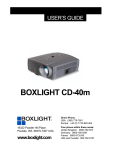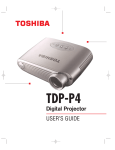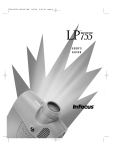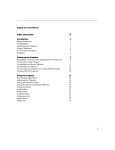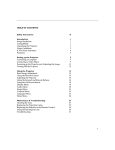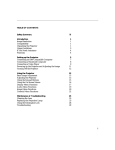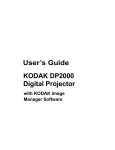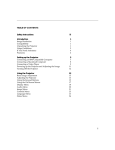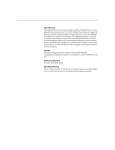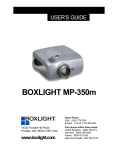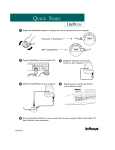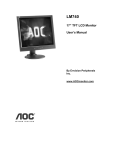Download InFocus LP 740 User's Manual
Transcript
TABLE OF CONTENTS Safety Summary iii Introduction Image Resolution Compatibility Unpacking the Projector Usage Guidelines If You Need Assistance Warranty 1 1 1 1 4 4 4 Setting up the Projector Connecting a Computer Connecting a Video Player Powering up the Projector and Adjusting the Image Turning Off the Projector 5 7 8 9 10 Using the Projector Basic Image Adjustment Adjusting the Projector Using the Remote and Keypad Buttons Using the On-Screen Menus Image control Custom setup Information 11 11 11 13 16 19 21 22 Maintenance & Troubleshooting Cleaning the Lens Cleaning the Fan Intake Filter Replacing the Projection Lamp Troubleshooting 25 25 25 26 29 i T a ii b l e o f C o n t e n t s Appendix Specifications Accessories Portable and Laptop Activation Chart Using Video Mirroring with a PowerBook Computer Projected Image Size RS-232 Terminal Specifications 33 33 34 35 40 41 43 Index 45 SAFETY SUMMARY Please read these instructions carefully before using your LP 740. Failure to comply with them could result in fire, electrical shock, personal injury or damage to equipment. These graphics are used throughout this manual to draw your attention to important information about the projectors. NOTE: Additional useful details or tips. CAUTION: Steps to take to avoid damage to your equipment. WARNING: Steps to take to avoid personal injury. These graphics are used on the projector’s labels. Attention - Refer to this User’s Guide for important safety information. CAUTION-Hot Surfaces - Avoid touching hot surfaces. Do not touch until the projector has cooled. Do Not Look Into The Lens! Be extremely careful not to look into the projection lens when the projector is turned on. The bright light may harm your eyes. Be especially careful to keep children from looking into the lens. Power Source Use only a three-wire grounding type power source. The power source should not exceed 250 volts rms between the supply conductors or between either conductor and the ground. Power Cord Use only the power cord that was shipped with the projector. Although other power cords might be similar in appearance, they have not been safety-tested with the projector. Do not use a power cord if it has become damaged or frayed. Contact your In Focus dealer or call In Focus if you need to replace your power cord. iii S a f e t y S u m m a r y Grounding The projector is grounded through the grounding conductor on the power cord. To avoid electric shock, plug the power cord into a properly wired receptacle. Do not defeat the purpose of the grounding-type plug. Lamp To avoid overheating and unacceptable image quality, replace the projection lamp with a lamp of the specified type. Refer to page 33 for lamp specifications and to page 26 for instructions on replacing the lamp. Lamp Compartment To avoid burns, do not open the lamp module door until the projector is turned off and the lamp has cooled for at least 30 minutes. Follow the instructions in this manual for lamp replacement carefully. Hot Surfaces Allow the projector to cool at least 30 minutes before replacing a lamp. When you open the lamp housing, be very careful not to touch the hot surfaces inside. Ventilation and Overheating Openings in the projector case provide ventilation to protect it from overheating. Keep loose papers and other objects well away from the grills. Do not place the projector on top of or close to a computer or other heat-producing equipment. Liquid Spills Do not set drinks on top of the projector. Spilled liquids can flow inside and cause damage. NOTE: If you open the projector case, you will void the warranty. iv Do Not Disassemble All service must be performed by an authorized In Focus service center. The only user-serviceable part in the projector is the projection lamp, which you can replace by opening the lamp cover on the bottom of the projector (see page 26). Do not open any other part of the projector. If your projector needs repair, call your local Authorized Service Provider or In Focus Technical Support as described on page 4. Before you call, refer to “Troubleshooting” starting on page 29 to see if you can resolve the problem yourself. INTRODUCTION The In Focus LP 740™ is a multimedia projector that packs SXGA graphics (1280x1024) with 16.7 million colors. It generates crisp, clear images using a new and innovative reflective technology. The LP 740 is ideal for high-performance business, engineering and imaging applications that demand exceptional resolution and color quality. Image Resolution The SXGA resolution of the 740’s projected image is 1280x1024. If your computer’s screen resolution is higher than 1280x1024, reset it to a lower resolution before you connect the 740. NOTE: You can resize your Compatibility by pressing the Resize button on The projector is compatible with a wide variety of computers and video devices, including: the keypad or remote. 640x480, 800x600, or 1024x768 images to 1280x1024 • IBM, SUN, SGI, and selected HP and DEC workstations, up to 1280x1024 resolution. • IBM-compatible computers, including laptops, up to 1280x1024 resolution. • Apple Macintosh and PowerBook computers up to 1280x1024 resolution. • Most standard VCRs, camcorders and laser disc players. Unpacking the Projector The projector comes with the items shown in Figure 1. Check to make sure all are included. Contact your In Focus dealer immediately if anything is missing. If you are experienced in setting up presentation systems, use the LP 740 Quick Start card that was included in the shipping box. For complete details on connecting and operating the projector, refer to this User’s Guide. User’s Guides are also available for download from our website at www.infocus.com. 1 I n t r o d u c t i o n 5 NOTE: The contents of your 1 shipping box may vary depending on the projector configuration 2 1 you’ve ordered. 3 10 4 9 8 5 7 6 FIGURE 1 Shipping box contents 2 1. LP 740 projector with lens cap 6. SGI adapters 2. power cord 7. S-video cable 3. LP 740 User’s Guide 8. computer cable 4. remote control and batteries 9. video cable 5. SUN adapters 10. audio cable 5 speakers keypad handle foot adjuster buttons lens cap FIGURE 2 Side view of projector IR receiver connector panel Computer Data Out Data In Video Audio Out L R Audio In L R Computer Audio In L R Remote power cord connector Video In S C RS-232 vent fan FIGURE 3 Back view of projector 3 I n t r o d u c t i o n Usage Guidelines • Do not look directly into the projection lens when the projector is turned on. The bright light may harm your eyes. • Do not block the grills on the projector. Restricting the air flow can cause it to overheat and turn off. If this happens, you must wait a minute before attempting to turn it back on. • Handle the projector as you would any product with glass components. Be especially careful not to drop it. • Avoid leaving the projector in direct sunlight or extreme cold for extended periods of time. If this happens, allow it to reach room temperature before use. • This projector is not intended for use in a mainframe computer room as defined in the Standard for the Protection of Electronic Computer/Data Processing Equipment, ANSI/NFPA 75. • Transport the projector in a vendor-approved hard or soft case. Part numbers for these cases are listed on page 34. Call your In Focus dealer to order. If You Need Assistance The first place to look for help is in this manual. Be sure to check the guidelines in “Troubleshooting” on page 29. If this manual doesn’t answer your question, call your In Focus dealer. You can also call In Focus Customer Service directly at 1-800-799-9911. Call between 5 a.m. and 5 p.m. PST, Monday through Friday. In Europe, call In Focus in The Netherlands at (31) 23-5540310. In Singapore, call (65) 740-6435. Or, send us an e-mail at [email protected] Our World Wide Web address is http://www.infocus.com. Warranty This product is backed by a limited one-year warranty. The details of the warranty are printed at the back of this manual. Longer term warranties can be purchased from your In Focus dealer. Refer to page 34 for part numbers. 4 SETTING UP THE PROJECTOR 1 Place the projector on a flat surface parallel to the floor. • The projector must be within 10 feet (3 m) of your power source and within 6 feet (1.8 m) of your computer. FIGURE 4 Placing the projector 2 Position the projector the desired distance from the screen. The distance from the lens of the projector to the screen determines the size of the projected image. Figure 5 shows three projected image sizes. For more information about image size, see “Projected Image Size” on page 41. 3 Make sure the projector and your computer are turned off. 15 ft. 1 6. ft. 3. 5 f t. 5.6 ft. 10 ft. 25 ft. FIGURE 5 Projected image size 5 S e t t i n g u p t h e P NOTE: Before you continue, r o j e c t o monitor make sure the projector and your r computer Computer equipment are turned off. If you’re Data Out connecting a computer, make sure Data In the distance between it and the projector is 6 feet or less. Video external speakers computer audio Audio Out L R Audio In L R Computer Audio In L R Video In S C composite video Remote wired remote FIGURE 6 Connector panel 6 L/R audio in RS-232 RS-232 input S-video Connecting a Computer 1 (Desktop models only) Locate the cable that connects the monitor to your computer. Unplug it from the computer. 2 Plug one end of the computer cable into the video connector on your computer; plug the other end into the Data In connector on the projector. NOTE: To connect a workstation, use the appropriate adaptors between the computer and monitor cables. To connect a Macintosh computer, you must purchase the appropriate adaptors. FIGURE 7 Connecting the projector to a computer Do you want to display the image on your computer’s monitor as well as on the projection screen? 1 Plug the monitor cable into the Data Out connector on the projector. Do you want to play your computer’s audio on the projector? 1 Plug either end of the audio cable into the audio connector on your computer. 2 Plug the other end of the audio cable into the Computer Audio In connector on the projector. NOTE: Many laptop computers do not automatically turn on their external video port when a projector is connected. Activation commands for some laptop computers are listed in the Appendix of this manual on page 35. NOTE: Some audio connectors may use the small radio jack plug and will require an adaptor to use the RCA composite connector. 7 S e t t i n g u p t h e P r o j e c t o r Connecting a Video Player 1 If your video player uses a round, one-prong composite video connector, you’ll need the audio and video cables. • If your video player uses a round, four-prong S-video con- nector, you’ll need the S-video cable and the audio cable. 2 Plug the video cable’s yellow connector into the “video-out” port on your video player (Figure 8). This port may be labeled “To Monitor.” • If you’re using an S-video cable, connect it to the “S-video out” connector on the video player. 3 Plug the other yellow connector into the composite Video In connector on the back of the projector. • If you’re using S-video, plug the other end of the cable into the “S-video” Video In connector on the projector. CAUTION: Your video player may also have a “Video Out” port composite video/audio for a coaxial cable connection. DO NOT use this to connect to the 15 S-video projector. Computer Data Out Data In Video Audio Out L R Audio In L R Remoto Audio In L R Computer Video In S C RS-232 audio/video cable FIGURE 8 Connecting the projector to a video player 4 Plug the audio cable’s white connector into the left “audio out” port on your video player. Plug the cable’s red connector into the right “audio out” port on the video player. 5 Plug the other end of the cable into the left and right Audio In ports on the projector. The projector is compatible with these major broadcast video standards: NTSC, NTSC 4.43, PAL and SECAM. It automatically adjusts to optimize its performance for the incoming video. 8 Powering up the Projector and Adjusting the Image 1 Remove the lens cap. 2 Plug the power cord into the back of the projector, then plug it into your electrical outlet. A surge-protected power strip is recommended if power surges are common in your area. NOTE: Always use the power cord that shipped with the projector. Computer Data Out Data In Video Audio Out L R Audio In L R Remoto Audio In L R Computer Video In S C RS-232 FIGURE 9 Connecting the power cord 3 Turn on the projector by pressing the Power button on the remote or keypad. • The Power LED on top of the projector lights. The Lamp LED blinks until the lamp reaches full power. Power Power Lamp Check Source FIGURE 10 LEDs 4 If you connected a video player, turn it on. 9 S e t t i n g u NOTE: With some computers, the order in which you power up the equipment is very important. Most computers should be turned on last, after all other peripherals p t h e P r o j e c t o r • Press the S-video or Video buttons on the remote or the Source button on the keypad (page 14) to display your video image. • Use the volume buttons to adjust the volume. 5 Turn on your computer. • Press the Computer button on the remote or the Source but- computer’s documentation to ton on the keypad (page 14) to display your computer image. determine the correct order. • If necessary, make adjustments to the image from the pro- have been turned on. Refer to your jector’s on-screen menus. You can do an automatic setup, or manually adjust different aspects of the image using the onscreen menus. To open the menus, press the menu button on the remote or keypad. For more information, see page 16. Turning Off the Projector To completely power off the projector, press and hold the Power button on the remote or keypad for 2 seconds. If you want to turn the projector back on immediately, you must allow 2 minutes for the lamp to cool. The lamp won’t light if it’s too hot. CAUTION: When you disconnect the projector after you have switched it off, always remove the power cord from the electrical outlet first, then remove it from the projector. 10 USING THE PROJECTOR This section describes how to use and make adjustments to the projector. It also provides a reference to the remote and keypad buttons and the options available from the on-screen menus. Basic Image Adjustment 1 Make sure you have powered up your equipment in the right order (page 9). Press the Auto button on the remote or choose “Auto Set Up” (page 19) in the menus to optimize the image. NOTE: In Focus has created a 2 If the image doesn’t display completely, adjust the zoom, adjust the height of the projector (page 12) or center the image by adjusting its horizontal or vertical position (page 19). Be sure the projector is at a 90 degree angle to the screen. mizes your computer’s display 3 If the image is out of focus, rotate the outer focus ring (page 11). 4 If the image appears to shimmer or if it has blurry vertical bars after you have adjusted the focus, adjust the Sync or Tracking (page 19). software program called In Focus Presents that automatically opti- when used with any In Focus projector. This free program is included with every projector and available for download from our website at www.infocus.com. 5 If the colors don’t look right, adjust the brightness (page 15). Adjusting the Projector To focus the image, rotate the outer focus ring (Figure 11) until the image is clear. To zoom the image, rotate the inner zoom ring. focus ring zoom ring FIGURE 11 Focus ring and zoom ring 11 U s i n g t h e P r o j e c t o r The projector is equipped with 2 self-locking foot adjuster buttons (Figure 12). They can vary in length from 0 to 50mm, allowing you to adjust the angle of projection. To raise the projector: 1 Press and hold the foot adjuster buttons (Figure 12). 2 Raise the projector to the height you want, then release the buttons to lock the feet into position. 2 FIGURE 12 Adjusting the height of the projector 12 Using the Remote Control and Keypad Buttons Power Lamp Check Power Source Menu Resize Sync Track Volume Enter FIGURE 13 Keypad Power Auto Resize Computer S-Video Video Track Sync Bright Menu these 2 buttons are for future expansion and are not used at this time Zoom (+) Zoom (-) Enter Mask LP740-RC-01 (03151) Mute Made in JAPAN InFOCUS 000001 Volume MODEL S/N Point Restore FIGURE 14 Remote Point the remote control at the projection screen or at the front or rear of the 740. The range for optimum operation is 30 feet. 13 U s i n g t h e P r o j e c t o r Power This turns the projector off and on. Press and hold the Power button for 2 seconds to turn the projector off. Source (Computer, Video, or S-Video on remote) When you have more than one source (computer or video) connected to the projector, select between them by pressing the Source button. Menu Press Menu to open the on-screen menus. For more information about the on-screen menus, see page 16. Resize Press this to toggle the image size between standard and enlarged. Arrow buttons Use these to select and adjust menu settings. Sync Press the Sync button to adjust the synchronization of the computer source using the Arrow buttons. Press the Sync button again to close the Sync menu. Tracking Press the Tracking button to adjust the tracking of the computer source using the Arrow buttons. Press the Tracking button again to close the Tracking menu. Enter This enters the selected item or adjustment. Volume Press the Volume button to adjust the volume using the Arrow buttons. Press the Volume button again to close the menu. 14 Remote Control Only Buttons Auto This activates the automatic signal detection and image adjustment. When the adjustments are complete, you have the option of sending them to the projector or returning to the previous settings. Bright Press this button to open the Brightness control to brighten or darken the image. Zoom (+) and Zoom (-) This allows you to zoom the image in and out. To zoom a particular portion of the image, first use the Point button to position the cursor on the area you want to zoom, then press the Zoom (+) button. Press the Restore button to unzoom the image, or use the Zoom (-) button. Point This puts a crosshair cursor on the screen. Use the Arrow buttons to move the cursor. Press Point again to remove the cursor. NOTE: You cannot use the Point Mask or masked. feature while the image is zoomed This allows you to cover the image with a “mask” or “curtain”, then reveal the image by moving the mask to the left or right or top or bottom. Use the Arrow buttons to move the mask. Press Mask again to remove the mask and view the entire image. Restore This restores the image to its unzoomed, unmasked state and removes the cursor. Mute This silences the speakers. To return the volume to its previous setting, press the Mute again. 15 U s i n g t h e P r o j e c t o r Using the On-Screen Menus The projector has on-screen menus that allow you to make image adjustments and change a variety of settings. Most of these adjustments aren’t available directly from the remote or keypad. To open the on-screen menus, 1 Press the Menu button on the remote or keypad to display the Main Menu. MENU MAIN Image Control Computer Audio Control Custom Setup Information Users Memory Save Users Merory Load System Reset Exit 2 Press the up and down Arrow buttons to move the cursor to the desired submenu. Press the Enter button to display that menu. If the word “More” appears at the bottom of the menu, move the cursor down past it using the down arrow button to see additional menu options. If the word “Submenu” appears opposite the selected submenu, press the Enter button to open a new submenu. If a scale bar or “On” or “Off” appear opposite the selected menu, you can adjust the setting. If arrows appear on both sides of an option, use the left and right arrow buttons on the remote or keypad to cycle through the options. 16 IMAGE CONTROL COMP 1/2 Auto setup start Sync 25 ---+--Track 1234 ---+--Contarst 7 ---+--Brightness 7 ---+--Auto Adjust OFF ON Resize OFF ON Save Exit Exit More IMAGE CONTROL VIDEO Color 65 ||| Tint -2 ---+--Sharpness OFF ON Signal Type NTSC Brightness 7 ---+--Contrast 7 ---+--Color Balance Submenu Save Exit Exit AUDIO CONTROL Volume 24 |||| OFF ON Mute Balance 0 ---+--Bass 0 ---+--Treble 0 ---+--Sound Mode LINEAR Save Exit Exit IMAGE CONTROL COMP 2/2 More H-Position ---+--V-Position ---+--H-Size ||..... V-Size ||..... Color Balance Submenu Save Exit Cancel 3 Use the Arrow buttons ( ting. and ) to adjust the desired set- 4 To save the new setting and return to the previous menu, move the cursor to Save Exit and press the Enter button. To cancel the changes in the setting, move the cursor to Cancel and press the Enter button. NOTE: The image control menu items are different for video and computer sources. 17 U s i n g t h e P r o j e c t o r Here is the menu structure: MAIN MENU Image Control FUNCTION SUBMENU Adjusts the projected image coming from different sources. Input source: Computer Auto Setup, Sync Tracking, Contrast, Brightness Auto Adjust, Resize H-Position, V-Position H-Size, V-Size Color Balance Input source: S-video or Composite Color, Tint, Sharpness, Signal type, Brightness, Contrast, Color Balance 18 Audio Control Adjusts quality of sound. Volume, Mute, Right/Left Balance, Bass, Treble, Sound mode Custom setup Enables various projector modes and settings. Menu position, View Source, Image mode, Power Save, Serial Set, Smooth Mode, Remote Information Displays projector information. Lamp timer, Input Signal, System version, H sync, V sync, Resolution, Users memory Save & Load the settings Save & Load 25 user’s settings System reset Reverts to factory defaults Image control IMAGE CONTROL COMP 1/2 Auto setup start Sync 25 ---+--Track 1234 ---+--Contarst 7 ---+--Brightness 7 ---+--Auto Adjust OFF ON Resize OFF ON Save Exit Exit More SUB MENU Auto Setup start Sync Track Contrast Brightness Auto Adjust Resize H-Position V-Position H-Size V-Size Color Balance IMAGE CONTROL COMP 2/2 More H-Position ---+--V-Position ---+--H-Size ||..... V-Size ||..... Color Balance Submenu Save Exit Cancel COLOR BALANCE R_Contrast 7 G_Contrast 7 B_Contrast 7 R_Bright 7 G_Bright 7 B_Bright 7 Default Value Save Exit Exit COMP |||||.... |||||.... |||||.... |||||.... |||||.... |||||.... FUNCTION Optimizes image automatically for computer sources. Adjusts synchronization. Adjusts tracking. Adjusts contrast. Adjusts brightness. If you select ON, the projector automatically periodically adjusts the sync and tracking of the image. Changes the image size to standard size or full size. Adjusts the horizontal position of the image. Adjusts the vertical position of the image. Adjusts the horizontal size of the image. Adjusts the vertical size of the image. R Contrast: Adjusts the red contrast. G Contrast: Adjusts the green contrast. B Contrast: Adjusts the blue contrast. R Bright: Adjusts the red brightness. G Bright: Adjusts the green brightness. B Bright: Adjusts the blue brightness. Video only adjustments Color Tint Sharpness Signal type Adjusts color. Adjusts tint. Adjusts the definition of the outline of the image. Selects signal type from NTSC, PAL or SECAM. If the projector cannot automatically select the signal type, you can select it manually with this menu. 19 U s i n g t h e P r o j e c t o r Audio control AUDIO CONTROL Volume 24 |||| OFF ON Mute Balance 0 ---+--Bass 0 ---+--Treble 0 ---+--Sound Mode LINEAR Save Exit Exit More SUB MENU FUNCTION Volume Adjusts the volume Mute Temporarily removes the sound Balance Balances the right and left sound output Bass Adjusts the bass Treble Adjusts the treble Sound mode Stereo enhance modes: Enhances the audio source. Linear: Normal stereo without extra processing Spatial: Simulates “3D space” feeling from a stereo source Mono: Mixes the mono audio source to the left and right channels Pseudo: Creates a “stereo-like” effect from mono inputs 20 Custom setup CUSTOM SETUP Menu Posi View Source OFF ON Image Mode Submenu Power Save Submenu Serial Set Submenu Smooth Mode OFF ON Remote Wireless Wired Save Exit Cancel SERIAL SET SUB MENU IMAGE MODE SUB MENU Rear Ceiling OFF OFF ON ON Save Exit Cancel POWER SAVE SUB MENU Band Rate 19200 9600 Stop Bits 1 2 Parity NONE EVN ODD Power Save1 Power Save2 Power Save3 Save Exit Cancel Save Exit Cancel OFF OFF OFF ON ON ON SUBMENU FUNCTION NOTE: Serial set is used for Menu Posi Adjusts the menu’s position on the screen from upper-left or right to lower-right or left RS-232 control from an external View Source Displays the active source (Computer, Video, or S-Video) Specifications” on page 43 for Image Mode Rear: Reverses the image for rear projection Ceiling: Reverses the image for ceiling-mounted projection details. Power Save Allows you to turn on and off 3 different power save modes. mode 1: Shuts off the lamp after 3 hours if no keypad button is pressed mode 2: Shuts off the lamp after 10 minutes if no input signal is detected mode 3: Shuts off the fan automatically 2 minutes after the lamp is turned off Serial Set Sets up transmission of input signals from RS-232 control. Band rate: 9600, 19200 bps Stop bit: 1, 2 Parity: odd, even, no parity Smooth Mode Smoothes the vertical lines of the image Remote Indicates if the remote is wired to the projector device. See “RS-232 Terminal 21 U s i n g t h e P r o j e c t o r Information This is a read-only menu that provides status on the projector and input source. INFORMATION Lamp Timer Input Signal Computer Video Rev. H-Sync V-Sync Resolution Exit 22 1H S-Video 1.05 75.00kHz 60.00Hz 1280x1024 SUBMENU FUNCTION Lamp Timer Shows the number of hours the lamp has been in use. Input Signal Shows the Input Source: Computer or Video or S-Video Rev. Shows the revision of software in the projector. H-Sync Shows the Horizontal sync frequency of the input source. V-Sync Shows the Vertical sync frequency of the input source. Resolution Shows the image resolution of the computer source. Signal Type Shows either NTSC, PAL, or SECAM (video source only) Users memory Save This option saves your settings so you can quickly restore them later. You must turn off Auto Adjust (page 19) to use the memory save feature. 1 Use the Arrow buttons to move the cursor to Users Memory Save, then press Enter. USER MEMORY SAVE 1/2 1.******** 2.******** 3.******** 4.******** 5.******** 6.******** 7.******** 8.******** 9.******** 10.******** 11.******** 12.******** 13.******** 14.******** 15.******** 16.******** Cancel More USER MEMORY SAVE 17.******** 19.******** 21.******** 23.******** 25.******** 2/2 More 18.******** 20.******** 22.******** 24.******** Cancel 2 Move the cursor to a memory number, then press Enter. A file-naming dialog box appears. 3 Use the up arrow to increment through the letters and numbers to name the file. Use the right arrow to move to the next space and enter another character. 4 Move the cursor (using the right arrow button) to Save & Exit when you are finished, then press Enter. 5 Confirm your selection by choosing Yes or No, then press Enter. Users memory Load This option sends saved settings to the projector. 1 Use the Arrow buttons to move the cursor to Users Memory Load, then press Enter. 2 Move the cursor to the file you want to load, then press Enter. 3 Choose Yes to send the settings to the projector. 23 MAINTENANCE & TROUBLESHOOTING This section describes how to: •clean the lens •clean the fan filter •replace the projection lamp •troubleshoot the projector Cleaning the Lens Follow these steps to clean the projection lens: 1 Apply a non-abrasive camera lens cleaner to a soft, dry cloth. • Avoid using an excessive amount of cleaner. • Abrasive cleaners, solvents or other harsh chemicals might scratch the lens. 2 Lightly wipe the cleaning cloth over the lens. 3 If you don’t intend to use the projector immediately, replace the lens cap. Cleaning the Fan Intake Filter The fan intake filter on the bottom of the projector catches dust and particles in the air. If the filter becomes clogged, the projector does not cool properly and may malfunction. To prevent this, clean the filter after every 100 hours of use. 1 Turn off the power and unplug the power cord. 2 Remove the filter door (Figure 15). • Remove the screw on the filter door and lift the door out. 25 M a i n t e n a n c e & T r o u b l e s h o o t i n g FIGURE 15 Removing the filter door 3 Clean the filter. • Use a vacuum cleaner set on low power to remove the dust and dirt. 4 Re-install the filter. Replacing the Projection Lamp WARNING: To avoid burns, allow the projector to cool for at least 30 minutes before you open the lamp module door. Never extract the lamp module while the lamp is operating. The lamp hour counter in the menus counts the number of hours the lamp has been in use. The LP 740 uses a metal halide bulb. These types of bulbs deteriorate over time. Replace the lamp when the brightness is no longer acceptable. The lamp LED blinks slowly after 950 hours; it blinks more rapidly after 1000 hours. You can order new lamp modules from your In Focus dealer. See “Accessories” on page 34 for information. Follow these steps to replace the projection lamp: 1 Turn off the projector and unplug the power cord. 2 Wait 30 minutes to allow it to cool thoroughly. 3 Place the projector on its side, then remove the 2 screws on the lamp module door (Figure 16). 4 Pull the lamp door up and remove it. 26 FIGURE 16 Removing the lamp door 5 Loosen the two non-removable screws on the outside of the module. CAUTION: Never operate the 6 Remove the module (Figure 17). projector with the lamp door open or removed. This disrupts the air flow and causes the projector to overheat. FIGURE 17 Removing the lamp module 27 M a i n t e n a n c e & T r o u b l e s h o o t i n g FIGURE 18 Installing a new lamp module 7 Align the new lamp module in the correct direction. WARNING: Do not drop the lamp module or touch the glass bulb! The glass may shatter and cause injury. 8 Gently push the module in as far as it goes. 9 Tighten the screws on the outside of the module. 10 Re-install the lamp door. 11 Plug in the power cord and turn the projector back on. 12 To reset the lamp hour timer in the menus, press and hold the Track and Sync buttons, then press the Power button (while still holding down the other buttons) for 3 seconds. Verify that the timer was reset by pressing the menu button, navigating to the Information menu, and viewing the Lamp Timer setting (see page 22). 28 Troubleshooting Problem: Nothing on projection screen •Make sure that the power cord is properly connected to a functional AC electrical outlet. Make sure that the power cord is also properly connected to the projector. •If the projector is plugged into a power strip, make sure the power strip is turned on. •Make sure you have removed the lens cap on the projection lens at the front of the projector. •Make sure the projector is switched on. •Check the projector’s lamp to ensure that it is securely con- nected in the lamp module. See “Replacing the Projection Lamp” on page 26. •Make sure that the cables do not have any bent pins. Problem: Color or text not being projected •You might need to adjust the brightness up or down until the text is visible. Refer to “Bright” on page 15 for more information. Problem: The screen resolution is not right •Make sure the computer’s video card is set for a resolution of no greater than 1280x1024. Problem: Image isn’t centered on the screen •Reposition the image. Refer to “H-Position, V-Position” on page 18. •Be sure the projector is at a 90 degree angle to the screen. Problem: Only the blue start-up screen displays •Verify that the cables are connected correctly. See page 7 through page 8 for connection procedures. •Verify that the proper input source is connected. See “Source” on page 14. 29 M a i n t e n a n c e & T r o u b l e s h o o t i n g •You might need to turn everything off and power up the equipment again in the proper order. Refer to your computer’s documentation to determine the correct order. •Make sure your laptop’s external video port is turned on. See the “Portable and Laptop Activation Chart” on page 35 or your computer’s manual for details. •Make sure your computer’s video board is installed and con- figured correctly. If you’re using Windows 3.x: 1 In the Windows Program Manager, double-click the Windows Setup icon in the Main program group. 2 Verify that the Display setting is 1280x1024 or less. If you’re using Windows 95: 1 Open “My Computer” icon, the Control Panel folder and then the Display icon. 2 Click the Settings tab. 3 Verify that the Desktop area is set to 1280x1024 or less. Also check the following: •Does your computer have a compatible video board? The pro- jector isn’t CGA or EGA compatible. •Is your computer’s video port activated? This is especially true for laptop computers. See “Portable and Laptop Activation Chart” on page 35. Problem: Image is too wide or narrow for screen •You might need to manually adjust the tracking to reduce or enlarge the projected image. Refer to Tracking on page 18. •Adjust the resolution of your video card if it’s greater than 1280x1024 pixels. 30 Problem: Image is out of focus •Turn the projection lens to focus the image. •Make sure the projection screen is at least 5 feet (1.5 m) from the projector. •Check the projection lens to see if it needs cleaning. Problem: Image and menus are reversed left to right •Rear projection mode is probably turned on. Turn “Rear” off in the Custom Setup menu. The image should immediately return to forward projection. See “Image Mode” on page 21. Problem: the projector displays vertical lines, “bleeding” or spots •Adjust the brightness. Refer to “Bright” on page 15 for more information. •Check the projection lens to see if it needs cleaning. Problem: no sound •Adjust volume. •Verify audio/input connections. •Adjust audio source. Problem: Image is “noisy” or streaked •Adjust the synchronization and tracking manually to find an optimal setting. See Sync and Tracking on page 18. •The problem could be with your computer’s video card. If possible, connect a different computer. Problem: Projected colors don’t match the computer or video player’s colors •Adjust the brightness, tint and/or contrast from the menus. Just as there are differences in the displays of different monitors, there are often differences between the computer image and the projected image. Refer to “Bright” on page 15, or Tint or Contrast on page 18. 31 M a i n t e n a n c e & T r o u b l e s h o o t i n g Problem: Lamp seems to be getting dimmer •The lamp begins to lose brightness when it has been in use for a long time. Replace the lamp as described in “Replacing the Projection Lamp” on page 26. Problem: Lamp shuts off •A minor power surge may cause the lamp to shut off. Turn the projector off, wait at least 2 minutes, then turn it back on. Before calling your dealer or In Focus Technical Support for assistance, please have the following information available: •the projector ’s serial number (located on the bottom label) •the resolution of your computer. Call In Focus Technical Support at 1-800-799-9911 between 5 a.m. and 5 p.m. PST, Monday through Friday. 32 APPENDIX Specifications The LP 740 must be operated and stored within the temperature and humidity ranges specified. Temperature Operating 0 to 35° C Non-operating -10 to 60° C Humidity Operating and non-oper. 5% to 95% relative humidity, non-condensing Dimensions 13.4 x 17.5 x 8.7 inches (34 x 44.5 x 22 cm) Weight 31.5 pounds (14.3 kg) unpacked Altitude Operating Non-operating 0 to 10,000 feet (3,048 meters) 0 to 40,000 feet (12,192 meters) Optics Focus Range 5.6 - 80 feet Lamp Type 250-watt metal halide Input Power Requirements 100-120V/220-240V, 4.3A/2.3A, 50/60 Hz Remote Control Batterry Two (2) AA alkaline batteries 33 A p p e n d i x Accessories Standard Accessories (ship with the projector) Part Number LP 740 Quick Start card 009-0347-xx LP 740 User’s Guide 010-0162-xx Remote control and batteries 590-0243-xx Shipping Box 110-0220-xx Projection Lamp Module SP-LAMP-LP740 Lens Cap 340-0460-xx A/V Cable 6 ft (1.8 m) 210-0053-xx S-video Cable 210-0129-xx Computer Cable 210-0130-xx SUN Adaptor 210-0131-xx SUN Monitor Adaptor 210-0132-xx SGI Adaptor 210-0133-xx SGI Monitor Adaptor 210-0134-xx Power Cords (one ships with projector, type depends on country) NOTE: Use only In Focusapproved accessories. Other products have not been tested with the projector. North American Power Cord 210-0023-xx Australian Power Cord 210-0027-xx UK Power Cord 210-0028-xx European Power Cord 210-0029-xx Danish Power Cord 210-0030-xx Swiss Power Cord 210-0031-xx Optional Accessories Soft Case CA-C135 ATA Shipping Case CA-C138 Ceiling Mount-LiteMount 740 SP-CEIL-LM740 LiteMount False Ceiling Plate LiteMount Pipe Tubing Extension SP-LTMT-EXT Rhapsody II Speakers SP-R2SPKR JBL Subwoofer SP-JBLSUB Portable Projector Stand nd SP-STND Year Advantage Service Plan (1 year extension) AS-LP740-12 3rd Year Advantage Service Plan (2 year extension) AS-LP740-24 2 34 SP-LTMT-PLT Portable and Laptop Activation Chart Many laptop computers do not automatically turn on their external video port when a secondary display device such as a projector is connected. Activation commands for some laptop computers are listed in the following table. (If your computer is not listed or the given command does not work, refer to the computer’s documentation for the appropriate command.) On some laptops, the activation function key is labeled with an icon, for example Computer or the text CRT/LCD. Key command to activate port Key command to de-activate port NOTE: Often, pressing the key commands once activates the Acer Ctrl-Alt-Esc (for setup) Ctrl-Alt-Esc (for setup) external video port, pressing it AST* ** FN-D or Ctrl-D FN-D or Ctrl-D again activates both the external Ctrl-FN-D Ctrl-FN-D and internal ports, and pressing it FN-F5 FN-F5 a third time activates the internal type from A:/IVGA/CRT type from A:/IVGA/CRT FN-F12 FN-F12 AMS FN-F2 FN-F2 AMT setup screen setup screen AT&T FN-F3 FN-F6 FN-F3 FN-F6 Advanced Logic Research Ctrl-Alt-V Ctrl-Alt-V Altima Shift-Ctrl-Alt-C Shift-Ctrl-Alt-L setup VGA/ Conf.Simulscan setup VGA/ Conf.Simulscan FN-F12 FN-F12 FN-F5 FN-F5 F2/Choose Option/F5 F2/Choose Option/F5 setup menu setup menu Shift-Ctrl-D Shift-Ctrl-D Ambra** Amrel* ** Apple see Mac Portable and Mac PowerBook Aspen automatic port. Refer to your computer’s documentation for details on your specific model. automatic 35 A p p e n d i x Computer Key command to activate port Key command to de-activate port Austin Ctrl-Alt-comma Ctrl-Alt-comma Award FN-F6 FN-F6 BCC* automatic reboot computer Bondwell LCD or CRT options after bootup reboot for LCD or CRT options to appear Chaplet** Chembook setup screen FN-F6 FN-F4 FN-F4 FN-F6 FN-F6 Commax Ctrl-Alt-#6 Ctrl-Alt-#5 Compaq* ** Ctrl-Alt-< Ctrl-Alt-> FN-F4 FN-F4 automatic automatic mode/? (for setup option) mode/? (for setup option) automatic automatic Alt-F for screen setup option Alt-F for screen setup option Data General Ctrl-Alt-Command Ctrl-Alt-Command Data General Walkabout 2 CRT/X at DOS prompt reboot Datavue Ctrl-Shift-M Ctrl-Shift-M DEC** FN-F5 FN-F5 FN-F4 FN-F4 Dell** Ctrl-Alt-< Ctrl-Alt-> Ctrl-Alt-F10 Ctrl-Alt-F10 FN-F8 (CRT/LCD) FN-F8 Compuadd* ** Digital* 36 setup screen FN-F6 FN-D FN-D FN-F12 FN-F12 automatic reboot FN-F2 FN-F2 Dolch dip switch to CRT dip switch to LCD Epson dip switch to CRT dip switch to LCD Everex* setup screen option setup screen option For-A Ctrl-Alt-Shift-C Ctrl-Shift-Alt-L Computer Key command to activate port Key command to de-activate port Fujitsu FN-F10 Gateway FN-F3 FN-F1/FN-F1 again simultaneous FN-F3 FN-F1 Grid* ** FN-F2, choose auto or simultaneous FN-F2 Ctrl-Alt-Tab Ctrl-Alt-Tab Hitachi FN-F7 FN-F7 Honeywell FN-F10 FN-F10 Hyundai setup screen option setup screen option IBM 970* automatic warm reboot IBM ThinkPad** reboot, enter setup menu FN-F2 FN-F7, select choice from setup menu FN-F1, select choice FN-F5, select choice PS/2 SC select choice (CRT, LCD, etc.) Infotel FN-F12 FN-F12 Kaypro boot up, monitor plugged in unplug monitor Kris Tech FN-F8 FN-F8 Leading Edge FN-T FN-T Mac Portable 100 no video port: not compatible Mac PowerBook 140, 145, 150, 170 no video port: requires a 3rd-party interface 160, 165, 180, 520, 540, 5300 Control Panel folder, PowerBook Display folder; Activate Video Mirroring 210, 230, 250, 270, 280, 2300 requires Apple Docking Station or Mini Dock warm reboot 37 A p p e n d i x Computer Key command to activate port Key command to de-activate port Magitronic FN-F4 FN-F4 Mastersport FN-F2 FN-F1 Micro Express* automatic warm reboot Micron FN-F2 FN-F2 Microslate* automatic warm reboot Mitsubishi SW2 On-Off-Off-Off SW2 Off-On-On-On NCR setup screen option setup screen option NEC* ** setup screen option setup screen option CRT at the DOS prompt LCD at the DOS prompt FN-F3 FN-F3 Olivetti* automatic automatic FN-O/* FN-O/* FN-F0 FN-F0 Ctrl-Alt-< Ctrl-Alt-> Panasonic FN-F2 FN-F2 Prostar Ctrl-Alt-S at bootup Ctrl-Alt-S at bootup Samsung* setup screen option setup screen option Sanyo setup screen option setup screen option Packard Bell* ** Sharp dip switch to CRT dip switch to LCD Sun SPARCDataview Ctrl-Shift-M Ctrl-Shift-M Tandy** Ctrl-Alt-Insert Ctrl-Alt-Insert setup screen option setup screen option Tangent FN-F5 FN-F5 Texas Instruments* setup screen option setup screen option Top-Link* ** setup screen option setup screen option FN-F6 FN-F6 Ctrl-Alt-End Ctrl-Alt-Home FN-End FN-Home Toshiba* ** 38 FN-F5 FN-F5 setup screen option setup screen option Computer Key command to activate port Key command to de-activate port Twinhead* FN-F7 FN-F7 FN-F5 FN-F5 Automatic Automatic WinBook Ctrl-Alt-F10 Ctrl-Alt-F10 Wyse software driven software driven Zenith** FN-F10 FN-F10 FN-F2 FN-F2 FN-F1 FN-F1 Ctrl-Shift-D FN-F1 Ctrl-Shift-D FN-F1 Zeos** * These manufacturers have models that automatically send video to the external CRT port when some type of display device is attached. ** These manufacturers offer more than one key command depending on the computer model. 39 A p p e n d i x Using Video Mirroring with a PowerBook Computer When you turn video mirroring (called SimulScan in newer PowerBooks-see below) on, the projector displays the same information that appears on your PowerBook’s built-in screen. When video mirroring is off, the projector acts like a separate display. To turn on video mirroring for the first time: 1 Open the Monitors control panel; click on Monitor 2. 2 Set the number of colors you want. 3 Open the Control Strip; click on the monitor icon. 4 Select “Turn Video Mirroring On.” Now you can turn video mirroring on and off from the Control Strip without having to open the Monitors control panel again. When using video mirroring and high color graphics such as slide shows, the projected image occasionally might turn black and white. If this happens, perform the following steps: 1 Turn off video mirroring. 2 Open the Monitors control panel. 3 Move the white menu bar to Monitor 2 to set the projector as the primary monitor. 4 Restart the PowerBook. Using SimulScan Some newer PowerBooks display images on an external monitor or projector differently than previous ones. When using SimulScan, the projector displays the same information that appears on your PowerBook To select SimulScan: 1 Open the Control Panel, then double-click Monitors and Sound. 2 In the Resolution list, choose the SimulScan mode, then click OK. 3 If this changes your display settings, a dialog box appears. Click OK to confirm the change. 40 Projected Image Size Use the chart and tables to help you determine projected image sizes. FIGURE 19 Projected image size Table 1: Image Size, Width and Height for lens at Maximum Image Size Distance to Screen (feet) 5.6 10 15 20 25 30 35 40 45 50 Diagonal (inches) 42 73 109 144 180 216 252 287 323 359 Width (inches) 33 57 85 113 141 169 197 225 253 281 Height (inches) 26 46 68 90 112 135 157 179 202 224 41 A p p e n d i x Table 2: Image Size, Width and Height for lens at Minimum Image Size Distance to Screen (feet) 5.6 10 15 20 25 30 35 40 45 50 42 Diagonal (inches) 29 51 76 101 126 151 176 201 226 251 Width (inches) 23 40 60 79 99 118 138 157 177 197 Height (inches) 18 32 48 63 79 94 110 126 141 157 RS-232 Terminal Specifications Communication configuration To control the LP 740 from your computer, connect the RS-232 cable and set your computer’s serial port settings to match this communication configuration: Setting Value Bits per second 192000 Data bits 8 Parity None Stop bits 1 Start bit 1 Command format All commands consist of 3 alpha characters followed by a request, all enclosed in parentheses. An example: (AAA####) where ( starts the command AAA denotes the command #### denotes the value to be written (leading zeros not necessary) ) ends the command NOTE: To assure the projector can process a command, wait 3 seconds before entering the next command. 43 A p p e n d i x Supported commands 44 Function Command Meaning Power PWR 1=ON, 0=OFF Volume LMP 1=Volume Up, 0=Volume Down Mute MTE 1=Mute On, 0=Mute Off Track TRC 1=Phase Up, 0=Phase Down Sync SYC 1=Sync Up, 0=Sync Down Bright BRT 1=Bright Up, 0=Bright Down Resize RES 1=Expansion On, 0=Expansion Off Source SRC 0=Computer 1=Video 2=S-video Menu MNU 1=Menu On, 0=Menu Off Zoom ZOM 1=Zoom +, 0=Zoom - Point PNT 1=Pointer On, 0=Pointer Off Mask MSK 1=Mask On, 0=Mask Off Cursor CSR 0=Up, 1=Down 2=Right, 3=Left connecting INDEX IBM-compatible computer 7 power cord 9 video player 8 A accessories, ordering 34 connector panel 6 activation commands for laptop com- cords. See cables puters 35 Custom Setup 21 adjusting audio 19 D image 19 displaying Information 22 volume 14 displaying on-screen menus 14 adjustments, saving 23 altitude limits 33 F assistance. See Technical Support filter, cleaning 25 Audio Control 19 auto adjustments 15 B buttons on keypad 14 H hot surfaces iv I IBM-compatible computers compatibility 1 C cables audio 7 composite video 8 ordering 34 power iii, 34 connecting 7 icons on projector labels iii on the projector 6 image S-video 8 adjusting 9, 11 video 8 auto adjusting 15 cleaning colors don’t match computer’s 31 fan filter 25 focusing 11 projection lens 25 has lines or spots 31 colors masking 15 don’t match monitor colors 31 not centered 29 not displayed 29 not displayed 29 compatibility out of focus 31 IBM-compatible 1 quality iv, 29–32 Macintosh 1 resizing 14 composite video cable resolution 1 connecting 8 restoring 15 computers, compatible 1 reversed 31 reversing 21 size 41 streaked 31 too wide or too narrow 30 zooming 11, 15 45 I n d e x Image Control 19 O Invert modes 21 on-screen menus Audio Control 19 L Custom Setup 21 labels on projector iii displaying 16 lamp Image Control 19 ordering 34 Information 22 overheating iv users memory load 23 replacing 26 users memory save 23 safety iii–iv timer 28 P turns off unexpectedly 32 pointer, using 15 laptop computers power cord connecting 9 activation sequence to allow grounding iv secondary display 35 ordering 34 compatibility 7 safety iii connecting IBM-compatible 7 Power Save modes 21 lens cap 34 power source, safety iii cleaning 25 power switch 10 safety iii power up sequence 10, 30 LP 740 cases 34 R hot surfaces iv repair. See Technical Support image size 5, 41 replacing projection lamp module 26 setting up 5 resetting lamp hour timer 28 specifications 33 resizing the image 14 turning off 10 resolution 1 turning on 9 restoring settings 23 ventilation and overheating iv restoring the image 15 voiding the warranty iv RS-232 connector 6 specifications 43 M Macintosh computers compatibility 1 masking the image 15 Menu button 16 menus. See on-screen menus monitor, projected colors don’t match 31 46 supported commands 44 S V safety guidelines iii–iv vertical lines displayed 31 saving adjustments 23 video mirroring on a PowerBook 40 Serial settings 21 Volume button 14 service. See Technical Support volume, adjusting 14 SimulScan, using with PowerBooks 40 Sound modes 20 W Source button 14 warranty iv, 34 speakers external 34 specifications 33 Z zooming the image 15 S-video connecting 8 T Technical Support in Europe 4 in Singapore 4 in USA 4 information to have on hand before you call 32 voiding the warranty iv temperature limits 33 test pattern 29 text not visible 29 timer, lamp 22 troubleshooting 29 turning off the projector 10 turning on the projector 9 47


















































